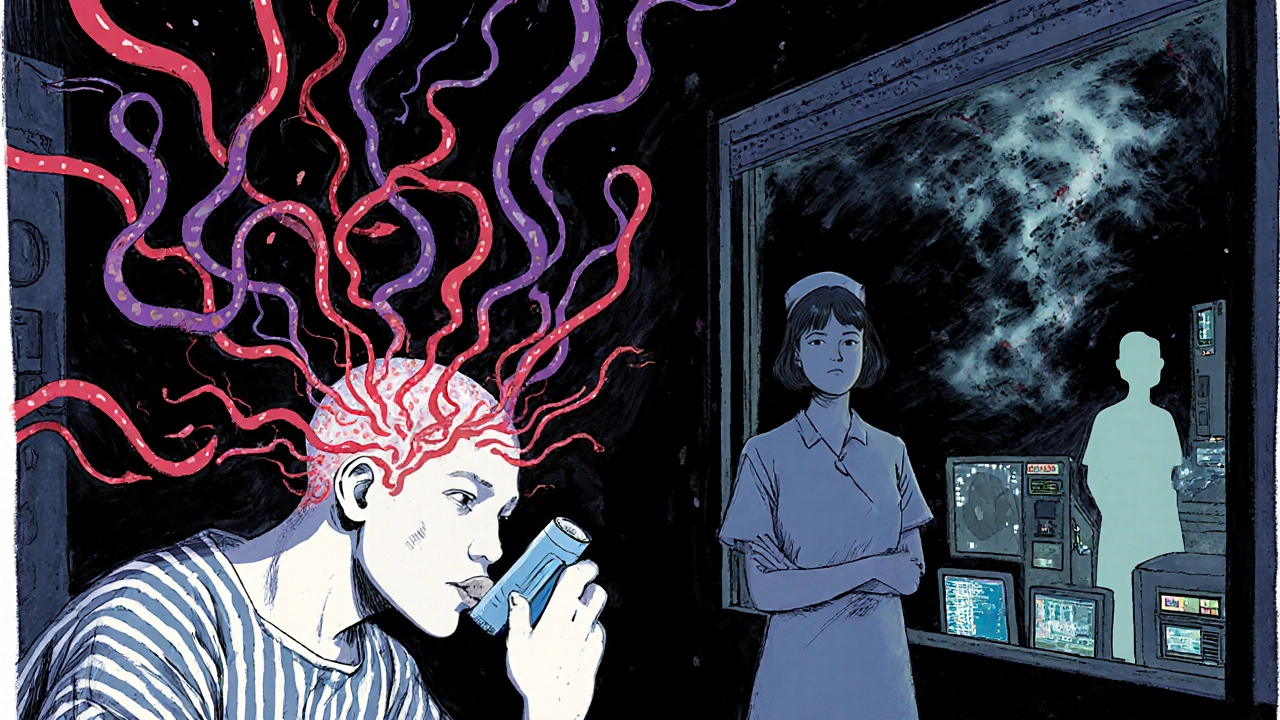Loxapine isn’t a drug you hear about every day, but for people struggling with severe psychosis or acute agitation, it can be a lifeline. Unlike newer antipsychotics that dominate headlines, loxapine has been around since the 1970s - and it still works. But how? What’s actually happening inside the brain when someone takes it? This isn’t just about pills and symptoms. It’s about chemistry, receptors, and the delicate balance of signals that keep thoughts from spiraling out of control.
What Loxapine Actually Is
Loxapine is classified as a typical, or first-generation, antipsychotic. It’s not new, but it’s not outdated either. It’s used primarily for treating schizophrenia and for managing sudden, severe agitation in psychiatric emergencies - often delivered as an inhaled powder through a device called Adasuve. That’s right: you can breathe it in. The inhaler form works in under 10 minutes, making it one of the fastest-acting options for calming someone in crisis.
It’s not prescribed for mild anxiety or occasional mood swings. Loxapine targets serious mental health conditions where a person loses touch with reality - hearing voices, believing things that aren’t true, or becoming so agitated they pose a danger to themselves or others.
How Loxapine Changes Brain Chemistry
The brain communicates through chemicals called neurotransmitters. One of the most important is dopamine. In people with schizophrenia, dopamine signaling goes haywire - too much in some areas, too little in others. This imbalance is linked to hallucinations, delusions, and disorganized thinking.
Loxapine works by blocking dopamine receptors, especially the D2 subtype. Think of dopamine receptors like locks, and dopamine as the key. When too many keys are turning locks at once, the system gets overloaded. Loxapine steps in and jams those locks, preventing dopamine from overstimulating the brain.
But it doesn’t stop there. Loxapine also blocks serotonin receptors - specifically 5-HT2A. That’s a key difference from older antipsychotics like haloperidol. By affecting both dopamine and serotonin, loxapine offers a broader effect on brain circuits involved in mood, perception, and impulse control. This dual action helps reduce both positive symptoms (like hallucinations) and some negative symptoms (like emotional flatness).
The Fast-Acting Inhaler: How It Works Differently
Most antipsychotics are taken as pills, which take hours to reach peak levels in the blood. Loxapine’s inhaler form bypasses the digestive system entirely. When inhaled, the powder is absorbed directly through the lungs into the bloodstream. Within minutes, it crosses the blood-brain barrier and starts binding to receptors.
In emergency rooms or psychiatric units, this speed matters. A person in violent agitation might be a danger to staff, other patients, or themselves. Waiting 30 to 60 minutes for an oral pill to work isn’t an option. The inhaled form reduces agitation in as little as 10 minutes, with most patients showing improvement within 20. Studies show it’s as effective as an intramuscular injection of haloperidol - but without the needle.
That’s why the FDA approved the inhaler in 2016. It’s not just a convenience - it’s a tool that reduces trauma for patients and lowers the risk of physical restraint.

Side Effects: What You Need to Know
Like all antipsychotics, loxapine comes with risks. The most common side effects include drowsiness, dizziness, dry mouth, and blurred vision. These usually fade after a few days as the body adjusts.
But there are more serious concerns. Loxapine can cause extrapyramidal symptoms - involuntary muscle movements like tremors, stiffness, or restlessness. In rare cases, it can trigger tardive dyskinesia, a condition where facial or limb movements become uncontrollable and may not go away even after stopping the drug.
Another rare but dangerous side effect is bronchospasm. That’s why the inhaler form comes with strict warnings: it shouldn’t be used by people with asthma, COPD, or other lung conditions. The powder can irritate airways and cause sudden breathing trouble. Patients are monitored for at least 30 minutes after each inhalation dose.
There’s also a small risk of neuroleptic malignant syndrome - a life-threatening reaction with high fever, muscle rigidity, and confusion. It’s rare, but if it happens, it requires immediate hospital care.
Who Benefits Most From Loxapine?
Loxapine isn’t for everyone. It’s typically chosen when:
- A person has schizophrenia that hasn’t responded well to other antipsychotics
- There’s a need for rapid control of acute agitation - especially in settings where injections aren’t preferred
- The patient or caregiver prefers non-injectable options for emergency use
- Cost is a factor: loxapine is significantly cheaper than newer atypical antipsychotics
It’s often used in state hospitals, emergency departments, and long-term care facilities where budgets are tight and outcomes matter more than brand names. For many, it’s the most reliable tool they have.

How It Compares to Other Antipsychotics
Compared to newer drugs like risperidone or olanzapine, loxapine has a higher chance of causing movement disorders. But it’s less likely to cause weight gain, high blood sugar, or high cholesterol - problems that plague many second-generation antipsychotics.
Here’s a quick comparison:
| Feature | Loxapine | Risperidone | Olanzapine | Haloperidol |
|---|---|---|---|---|
| Speed of action (inhaler) | 10-20 minutes | Not available | Not available | Not available |
| Dopamine blockade | Strong D2 | Moderate D2 | Moderate D2 | Very strong D2 |
| Serotonin effect | Yes (5-HT2A) | Yes | Yes | No |
| Weight gain risk | Low | Moderate | High | Low |
| Movement side effects | High | Moderate | Low | Very high |
| Cost (30-day supply) | $20-$50 | $100-$200 | $150-$300 | $15-$40 |
Loxapine sits in the middle: not the gentlest, but not the most toxic either. Its unique value is speed - especially when delivered by inhalation.
Why It Still Matters Today
Even in an age of fancy new drugs and personalized medicine, loxapine hasn’t been left behind. It’s a reminder that sometimes the oldest tools are the most practical. For patients without insurance, for emergency teams working under pressure, or for those who’ve tried everything else - loxapine delivers results.
Its mechanism is simple: block dopamine, calm the storm. But the impact is profound. It gives people back hours - sometimes days - of clarity. It gives families a chance to breathe. And it gives clinicians a reliable option when seconds count.
The science behind loxapine isn’t glamorous. No gene therapy. No AI-driven dosing. Just chemistry, receptors, and a drug that’s stood the test of time because it works - when used correctly.
Is loxapine used for anxiety?
No, loxapine is not approved or recommended for general anxiety. It’s designed for severe psychiatric conditions like schizophrenia and acute agitation. Using it for mild anxiety could lead to unnecessary side effects and doesn’t address the root cause. Anti-anxiety medications like SSRIs or benzodiazepines are better suited for that.
Can you take loxapine long-term?
Yes, but it’s usually not the first choice for long-term maintenance. Due to its higher risk of movement disorders, doctors often switch patients to atypical antipsychotics like aripiprazole or quetiapine for ongoing treatment. Loxapine is more commonly used for acute episodes or when other drugs fail.
Does loxapine cause weight gain?
Compared to other antipsychotics, loxapine causes minimal weight gain. Studies show patients on loxapine gain less than 2 pounds on average over six months, while drugs like olanzapine can cause 10-15 pounds of weight gain in the same period. This makes it a better option for people concerned about metabolic side effects.
Is the inhaler form safe for everyone?
No. The inhaled form is contraindicated in people with asthma, COPD, or other chronic lung diseases. Even in healthy individuals, it can cause bronchospasm - a sudden tightening of the airways. That’s why it’s only administered in supervised settings with monitoring equipment ready.
How does loxapine compare to electroconvulsive therapy (ECT)?
Loxapine and ECT serve different purposes. ECT is used for severe depression, catatonia, or treatment-resistant psychosis when medications have failed. Loxapine is used for rapid control of agitation or as part of ongoing schizophrenia treatment. They’re not alternatives - they’re tools for different stages of illness. Some patients may receive ECT after loxapine fails to control symptoms.

kelly mckeown
November 1, 2025 AT 21:54i’ve seen loxapine work on my brother during a crisis-no needles, just a puff, and within minutes he stopped screaming. it wasn’t magic, but it was the first time in years he looked like himself again. i’m not a doctor, but i know what i saw.
Tom Costello
November 2, 2025 AT 02:42the fact that this drug is still in use-and even has an inhaler-is a quiet win for practical medicine. no flashy branding, no billion-dollar ad campaigns, just chemistry that works when you need it most. it’s the kind of tool that keeps emergency rooms from turning into war zones.
Susan Haboustak
November 3, 2025 AT 14:27you people act like this is some miracle drug. it’s a 50-year-old antipsychotic with a 30% chance of making your face twitch. and you’re celebrating the inhaler? great. now you’ve got people breathing in a neurotoxin instead of getting injected. same risk, less dignity. and don’t even get me started on how often it’s used because hospitals can’t afford risperidone.
Chad Kennedy
November 4, 2025 AT 19:23so… it’s just a cheap way to calm people down? why not just use sedatives? this sounds like a bandaid on a bullet wound.